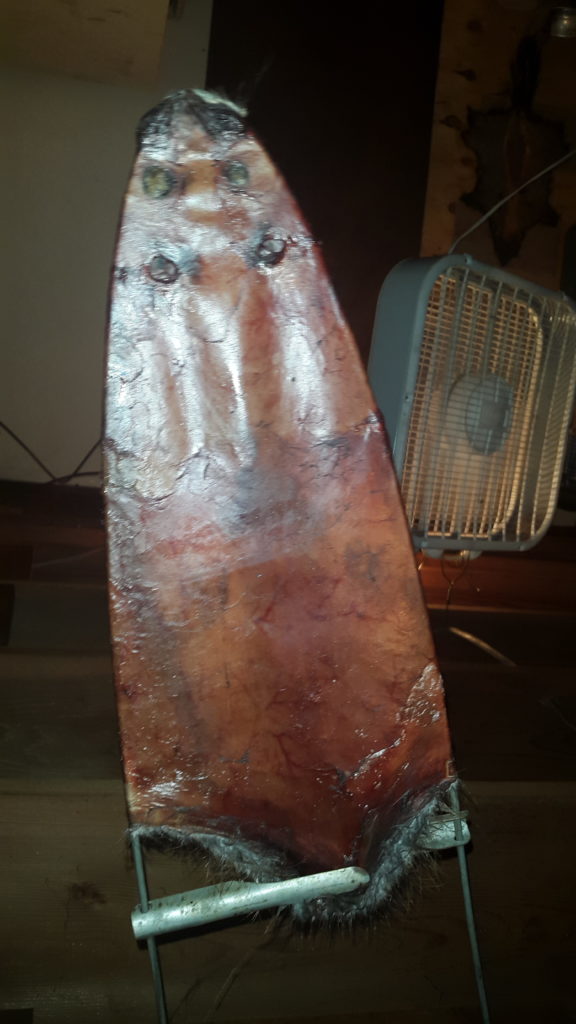
Despite low prices, muskrats can still be profitable in the right situations
by Jason Houser
Muskrats were sold at prices a few years ago that most trappers have never seen, and will probably not see again for some time. Muskrat prices look to be good for the past season if trappers sell late, but do not look for them to be as high as what trappers were getting not all that long ago for big, well-furred muskrats. With that being said, muskrats are worth the effort.
Muskrats are not difficult to trap if you can find a good population. Over the last few years the muskrat population seems to have declined somewhat. The muskrat was the first animal I trapped, and I still love to trap them today.
It does not take a big, powerful trap for to catch and hold a muskrat. I either use a 1½ coilspring or a #110 conibear. One thing nice about the 1 ½ is that it is also large enough to hold any coon or mink that happens to come along. The conibear is my go-to trap at den entrances and runs.
It wasn’t that many years ago when trappers were able to fetch $10 or even more from a good muskrat pelt. If you have tried to sell muskrats recently, you know that is no longer the case. The bottom has not dropped out of muskrats, but three to five dollars will be a good price.
Put it in Perspective
Three dollars does not sound like a lot of money for a prime pelt, but consider what you are doing for that three dollars.
It is not uncommon to be able to pull up to a farm pond that has several muskrat runs and huts, and set out a dozen traps and walk away with 8 or 10 muskrats. That number could be even higher if you are in a state that will allow you to use colony traps. What if you had several of those ponds available? The numbers quickly add up.
If you have three ponds always at the ready, and are able to pull an average of 6 muskrats a day out of a pond for three days before moving on, you will have pretty good numbers of fur in the shed.
That equals to 18 muskrats a day, at a 3-dollar average for a total of fifty-four dollars. Of course, you need to consider expenses like gas, but hopefully you are not driving far, and all the ponds are in close proximity to one another.
If you have the muskrat population and the time to trap for two months, you are looking at a gross profit of over $3,000. That does not include the other catches you will make like mink, coons, otter, beaver, coyotes and foxes that are both incidental and targeted catches that will add money to your paycheck.
Now if you were in an area of the country that was covered in muskrat marshes, and muskrat huts were visible as far as the eye could see, you are in for a treat. Catches of fifty or more muskrats in a day are not unheard of, and once you are in that particular location, there is no more expense in traveling to the next location.
Of course, these areas are hard to come by, but they do exist. The competition for trapping grounds is not as fierce as it was a few short years ago, so you might have the area all to yourself. But there will still be some die-hard trappers like yourself out there that love the sport of trapping as much as you do, and they happen to know of your secret muskrat honey-hole. If that is the case, simply be considerate and respectful of their sets.
standard sets
I normally use conibears when setting runs, den entrances and bottom edge sets. One of the best sets is when you are able to find the entrance to a den, and set a trap in front of the entrance. Remember that it is illegal to set a trap inside a muskrat lodge. Runs are deep channels caused by swimming muskrats. This is a good place to set and stabilize a #110.
Bottom-edge sets became popular with mink trappers, but they are effective for muskrats as well. Especially when dens and runs are hard to find. When walking streams, search for a point that sticks out in the water. The point should be almost vertical for best results. You will come across a lot of points, so it might be hard to decide which one to set a trap at. The best point will be one that a muskrat cannot see around, causing him to hug tight to the point. Set and stabilize a conibear the furthest tip of the projection.
Floats
Many muskrats have ended up in my fur shed using muskrat floats. Thousands of muskrats are caught each year using muskrat float sets. A float set is nothing more than a platform that the muskrats can climb aboard to eat on. A normal float consists of two 1 ½ coilsprings attached to the underside of the float and an ear of corn used as bait centered between the two traps. When the muskrat steps on the trap’s pan and gets caught, the muskrat should end up in the water, and because of the weight of the trap it will not be able to climb back on the float and will quickly drown. Floats can be purchased from most trapping supply dealers, or can easily be made at home for very little expense. It is not uncommon to catch doubles on this set. This set is good at any location, but especially helpful when no other sign is available to set a trap, even though you know muskrats are present.
Pocket Sets
Many coon trappers can tell you that muskrats are also interested and easily caught at pocket sets. If you intend to make pocket sets with the sole purpose of catching a ‘rat or two it is then time to use a good muskrat gland lure, food lure or a bait placed inside the pocket. If you want your set to catch muskrats and any passing mink, leaving most of the coon be, make your pocket hole no bigger around than the trap. Keep the opening this size, but widen it out as you go deeper into the bank. Slick up the side of the pocket to give it the appearance that it is used often, and set the trap just outside the pocket on a slide wire drowning system.
Muskrat trapping may not be as appealing as a big old coyote might be, but ‘rats are good for both the beginner and expert trapper. Sets are easy and quick to make, and with a high population of muskrats it is easy to make some money on these little critters.
